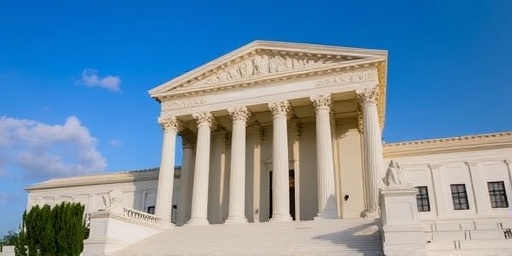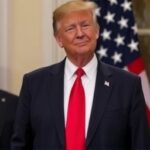In a move that could redefine access to the ballot box across the nation, the U.S. Supreme Court has agreed to expedite arguments on challenges to stringent voter ID requirements and mail-in ballot restrictions in key battleground states. This decision, announced late Friday, thrusts the nation’s highest court into the heart of heated debates over 2024 Election integrity, potentially altering voting procedures just months before voters head to the polls.
The cases, consolidated from states like Georgia, Pennsylvania, and Wisconsin, stem from a flurry of election laws enacted post-2020 to tighten voting safeguards. Civil rights groups and Democratic-led coalitions argue these measures disproportionately disenfranchise minority and low-income voters, while Republican lawmakers defend them as essential bulwarks against fraud. With oral arguments slated for early October, the court’s ruling—expected by late November—could set binding precedents for the November 5 general election.
This fast-tracked review underscores the Supreme Court‘s growing role in electoral disputes, echoing its intervention in Bush v. Gore two decades ago. Legal experts warn that the outcome might not only influence turnout in swing states but also spark a wave of similar litigation nationwide.
Battleground States Ignite Voter ID Firestorm
At the epicenter of this legal showdown are battleground states where razor-thin margins decided the 2020 presidential race. Georgia’s Senate Bill 202, dubbed the “Election Integrity Act,” mandates photo ID for absentee ballots and limits drop boxes, prompting lawsuits from the ACLU and voting rights advocates. In Pennsylvania, a federal appeals court recently upheld a law requiring voters without ID to submit sworn affidavits, but challengers claim it creates undue barriers for over 1.2 million registered voters lacking current identification, according to a Brennan Center for Justice report.
Wisconsin’s landscape is equally contentious. The state’s 2022 law, passed amid GOP control, bans private funding for elections and restricts early voting hours, which critics say suppresses urban turnout. Data from the U.S. Census Bureau indicates that in 2020, 68% of Black voters in these states used mail-in or early options, compared to 52% of white voters—a disparity that could widen under stricter election laws.
“These laws aren’t about security; they’re about subtraction—subtracting voices from the electorate,” said Stacey Abrams, founder of Fair Fight Action, in a statement to reporters. On the other side, Georgia Secretary of State Brad Raffensperger defended the measures, stating, “Voter ID is a commonsense reform that 80% of Americans support, ensuring every vote counts without fraud.” Polls from Pew Research back this, showing broad bipartisan approval for ID requirements, though implementation details fuel the divide.
The Supreme Court‘s decision to consolidate these cases under Rule 11, which allows for expedited dockets in matters of national urgency, signals the justices’ awareness of the ticking clock. Justices across the ideological spectrum, from liberal Sonia Sotomayor to conservative Clarence Thomas, have previously weighed in on voting rights, but this term’s 6-3 conservative majority could tilt toward upholding state restrictions.
Mail-In Ballots Face Renewed Restrictions and Legal Battles
Mail-in voting, which surged to 46% of all ballots in 2020 amid the COVID-19 pandemic, now hangs in the balance as states impose new hurdles. In Michigan, a proposed constitutional amendment to enshrine no-excuse absentee voting is entangled in related federal challenges, while Arizona’s ban on ballot harvesting—where third parties collect and submit mail-in votes—has been partially struck down but awaits higher review.
The Supreme Court‘s involvement amplifies concerns over accessibility. A 2023 study by the MIT Election Data and Science Lab found that mail-in restrictions could reduce turnout by up to 2% in urban areas, potentially shifting outcomes in close races. For instance, in Nevada, where mail-in ballots comprised 55% of votes in 2020, new signature-matching rules have led to thousands of rejections, disproportionately affecting elderly and disabled voters.
Legal heavyweights are lining up on both sides. The Heritage Foundation, a conservative think tank, filed an amicus brief supporting the restrictions, citing isolated fraud cases like the 2020 Pennsylvania ballot-duplication scandal involving nine military votes. Conversely, the NAACP Legal Defense Fund argues that such incidents are rare—less than 0.0001% of ballots per a 2022 Stanford study—and that the real threat is voter suppression.
“The 2024 Election is too critical to let bureaucratic barriers silence millions,” remarked Marc Elias, a prominent Democratic election lawyer who represents the challengers. He pointed to historical turnout data: In 2016, strict mail-in rules correlated with a 3-5% drop in participation among low-propensity voters. As arguments approach, lower courts in these states have issued mixed injunctions, creating a patchwork of rules that confuses voters and election officials alike.
From 2020 Chaos to 2024 Safeguards: Tracing the Legal Evolution
The roots of these challenges trace back to the tumultuous 2020 election, where over 96 million Americans voted by mail, shattering records. Post-election audits in states like Arizona’s Maricopa County revealed no widespread fraud, yet fueled a legislative backlash. By 2023, 20 states had enacted 42 new election laws, per the National Conference of State Legislatures, many targeting mail-in processes and ID verification.
The Supreme Court has waded into this arena before. In Brnovich v. Democratic National Committee (2021), the court curtailed federal oversight under the Voting Rights Act, allowing Arizona’s out-of-precinct and ballot-collection bans to stand. This precedent looms large, as challengers now invoke the 14th Amendment’s equal protection clause, arguing that disparate impacts on protected groups violate constitutional norms.
Statistics paint a stark picture: The U.S. Election Assistance Commission reports that 11% of voting-age citizens—roughly 25 million people—lack government-issued photo ID, with higher rates among Black (25%) and Hispanic (16%) communities. In battleground states, this translates to potential disenfranchisement of 500,000 voters, according to Democracy Docket estimates.
Experts like election law professor Rick Hasen from UC Irvine highlight the irony: “While fraud claims drove these election laws, evidence shows they’re more likely to dilute than protect the vote.” Hasen, author of “Election Meltdown,” predicts the court might sidestep a sweeping ruling, instead remanding cases for narrower fixes, preserving state autonomy under the Elections Clause.
Internationally, the U.S. approach draws scrutiny. Organizations like the OSCE Office for Democratic Institutions and Human Rights have criticized restrictive voting measures in observer reports, noting they fall short of standards ensuring inclusive elections.
Voices from the Frontlines: Stakeholders Clash Over Election Integrity
The fast-tracked cases have mobilized a chorus of stakeholders, from grassroots activists to corporate leaders. In Georgia, Black Voters Matter co-founder LaTosha Brown organized rallies outside the state capitol, emphasizing personal stories: “My grandmother, a lifelong voter, was turned away last primary because her ID expired during the pandemic. This isn’t abstract—it’s real lives at stake.”
Republican governors in affected states, including Pennsylvania’s Josh Shapiro (a Democrat who has navigated bipartisan tensions), urge caution. Shapiro, facing his own reelection, told CNN, “We need secure elections without alienating voters. The Supreme Court can thread that needle.” Meanwhile, the U.S. Chamber of Commerce filed briefs supporting flexible rules, warning that disenfranchisement hurts business by eroding democratic legitimacy.
Civil liberties groups decry the timing. The League of Women Voters, with over 800,000 members, launched a “Vote Unrestricted” campaign, citing a 2023 Gallup poll where 62% of Americans oppose new barriers. On the flip side, True the Vote, a conservative watchdog, celebrated the review, claiming it addresses “systemic vulnerabilities exposed in 2020.”
Polls reflect the polarization: A Monmouth University survey from September 2023 found 55% of Republicans favor stricter ID laws, versus 28% of Democrats. Yet, 70% overall support mail-in options, per AP-NORC, highlighting a potential middle ground the court might explore.
Amid the rhetoric, election administrators face practical woes. In Wisconsin, county clerks report staffing shortages exacerbated by legal uncertainty, with turnover rates up 20% since 2020, according to the National Association of Election Officials.
Horizons for 2024: What a Supreme Court Ruling Could Mean
As the Supreme Court prepares to deliberate, the stakes for the 2024 Election couldn’t be higher. A ruling upholding the challenged election laws might embolden red states to further restrict access, potentially lowering turnout in Democratic strongholds and tipping scales in the presidential contest between likely nominees Joe Biden and Donald Trump.
Conversely, striking down key provisions could standardize more permissive voting nationwide, boosting participation. Projections from the Bipartisan Policy Center suggest relaxed mail-in rules could add 5-10 million voters, many in underrepresented groups. This might reshape down-ballot races too, influencing control of Congress and statehouses.
Looking beyond 2024, the decision could catalyze federal legislation. Bipartisan bills like the Freedom to Vote Act, stalled in the Senate, might resurface, aiming to preempt state variations with national standards. International implications loom as well; a perceived erosion of voting rights could damage U.S. credibility in promoting global democracy.
Legal scholars anticipate oral arguments will probe not just legality but necessity. Chief Justice John Roberts, often a swing vote, has emphasized institutional trust: In a 2022 Shelby County v. Holder dissent reference, he noted, “Elections must be both secure and accessible.” With midterms fresh and 2024 looming, the court’s words—and ultimate decree—will echo far beyond the marble halls of Washington.
In the interim, advocacy groups ramp up voter education drives, distributing free ID clinics and absentee guides. States like Colorado, with universal mail-in systems untouched by these suits, serve as models of efficiency, boasting 90% turnout rates. As November nears, all eyes remain on the Supreme Court, where the future of American voting hangs in delicate balance.









